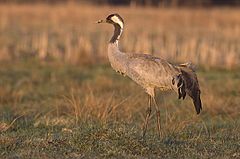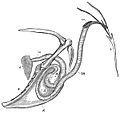Common crane facts for kids
Quick facts for kids Common crane |
|
|---|---|
 |
|
| Conservation status | |
| Scientific classification | |
| Kingdom: | |
| Class: | |
| Order: | |
| Family: | |
| Genus: | |
| Binomial name | |
| Grus grus (Linnaeus, 1758)
|
|
The common crane (Grus grus), also called the Eurasian crane, is a large bird from the crane family, Gruidae. It's the most common type of crane you'll find in Europe, besides the demoiselle crane. These amazing birds are known for their long legs, graceful flight, and loud calls.
Contents
Where Do Common Cranes Live?
Common cranes live in many different places across Europe and Asia. They like to build their nests in boreal and mixed forests. You can find them from sea level all the way up to 2,200 meters (about 7,200 feet) high!
These cranes also enjoy open areas like moors, bogs, and wetlands with short heather plants. They especially love places where small lakes or pools are nearby. Water is very important for them.
Favorite Breeding Spots
In Sweden, common cranes often nest in small, swampy clearings within pine forests. In Germany, they prefer marshy wetlands. Russia has similar breeding spots. However, cranes there can also be found nesting in dry steppe areas or even semi-deserts, as long as there's water nearby.
Mostly, common cranes choose quiet, peaceful places to raise their young. They don't like a lot of human activity. They live spread out, with only about 1 to 5 pairs in every 100 square kilometers (about 38 square miles).
Winter Homes and Molting
When winter comes, common cranes fly to warmer places. They look for flooded areas, calm bays, and swampy meadows. During a time called molting, they lose their old feathers and grow new ones. At this time, they can't fly. So, they need shallow water or tall reed plants to hide from danger.
After their long migration, cranes often spend winter in open areas. They might be seen on farms or even in savanna-like places, such as in Spain and Portugal.
Cranes Return to Britain
Good news! Common cranes are now back in Britain after being gone for about 300 years. They disappeared because their favorite fen lands were drained. The fens were low-lying wetlands that the cranes loved. Now, with conservation efforts, these beautiful birds are slowly returning to their old homes.
Images for kids
-
Common cranes in Osmussaar, Estonia. Wetlands are preferred habitats for the cranes.
-
"Departure of Cranes" - picture of 1870 by Józef Chełmoński (National Museum in Cracow)
-
Adults and immatures at Keoladeo National Park, India
-
A smal flock of Cranes in flight, Ystad 2022.
See also
 In Spanish: Grulla común para niños
In Spanish: Grulla común para niños






















